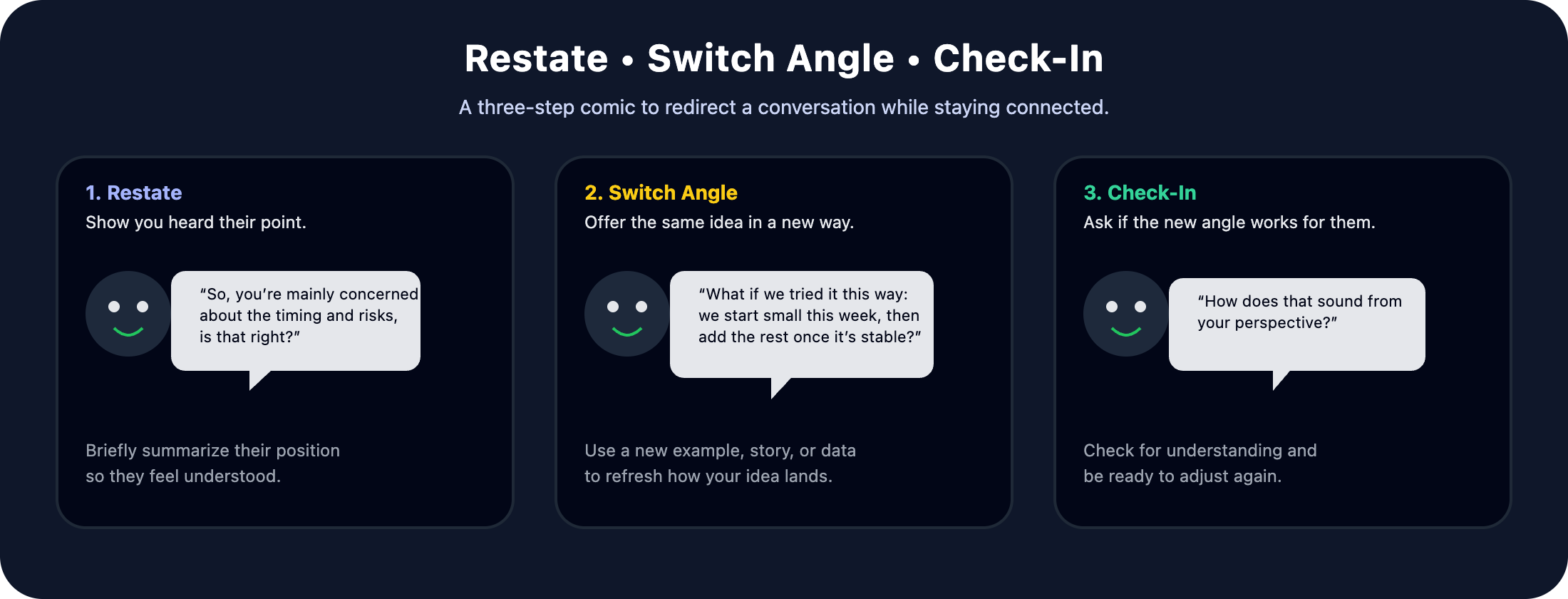Even the most well-prepared persuaders encounter moments when their message simply isn’t landing. Recognizing when your current approach isn’t working and knowing how to pivot effectively can mean the difference between a stalled conversation and a breakthrough. The ability to adapt in real time is a hallmark of skilled compromise and persuasion. In this lesson, you’ll learn how to spot the signs that your message isn’t resonating, experiment with new angles, and directly engage your counterpart to discover what they need to move forward.
The first step in pivoting is awareness. Often, we become so invested in our own arguments that we miss the subtle (or not-so-subtle) cues that our message isn’t connecting. Watch for signs such as:
- The other person repeating objections or concerns you thought you’d addressed
- Body language that signals disengagement (crossed arms, lack of eye contact, distracted behavior)
- Short, noncommittal responses (“I guess,” “Maybe,” “We’ll see”)
- A shift in energy—conversation stalls, or the other person seems frustrated or checked out
When you notice these signals, pause. Acknowledge that your current approach may not be working, and prepare to try something different. This prevents you from doubling down on a failing strategy and opens the door to more effective persuasion.
When your initial approach isn’t effective, it’s time to pivot. One practical way to do this is by using the “Switch-Up” Framework:

Let’s see how the “Switch-Up” framework might look in a general, everyday conversation between Natalie and Jessica:
- Natalie: I think we should try that new Italian restaurant for dinner tonight. I’ve heard great things about it.
- Jessica: I’m not sure—I’ve been feeling a bit tired, and I don’t really want to go somewhere crowded or noisy.
- Natalie: So you’re feeling tired and want to avoid a busy, loud place tonight.
- Natalie: What if we ordered takeout from the Italian place instead and had a quiet dinner at home? That way, we can still try the food without dealing with the crowds.
- Natalie: Would that work for you, or is there something else you’d prefer for dinner tonight?
This dialogue shows Natalie acknowledging Jessica’s concerns, suggesting a new approach, and checking in to see if it meets Jessica’s needs. This framework keeps the conversation collaborative and shows your willingness to adapt, which builds trust and increases the likelihood of finding common ground.
Sometimes, the most effective pivot is to stop guessing and ask directly. If you sense resistance or confusion, invite the other person to share what would help them move forward. This not only demonstrates respect for their perspective but also uncovers information you might have missed.
You can try questions like:
- “What would make you feel more comfortable with this idea?”
- “Is there something specific you need to see or hear to get on board?”
- “What’s your biggest concern right now, and how can we address it together?”
By asking these questions, you shift from persuading to problem-solving. You may discover a simple adjustment or additional information is all that’s needed to reach agreement. This approach transforms the conversation from a tug-of-war into a collaborative search for solutions.
By mastering the art of pivoting, trying new angles, and asking directly what’s needed, you’ll become a more agile and effective persuader, capable of turning stalled conversations into opportunities for genuine compromise. In the upcoming exercises, you'll have a chance to put these skills into practice.
